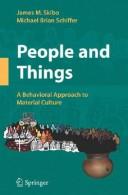| Listing 1 - 2 of 2 |
Sort by
|
Book
ISBN: 9781461441991 9781461441984 1461441986 9786613936295 1461441994 1283623846 Year: 2013 Publisher: New York, NY : Springer New York : Imprint: Springer,
Abstract | Keywords | Export | Availability | Bookmark
 Loading...
Loading...Choose an application
- Reference Manager
- EndNote
- RefWorks (Direct export to RefWorks)
The 1992 publication of Pottery Function applied ethnoarchaeological data collected among the Kalinga and experiments to set forth the principles for the creation of pottery use-alteration traces (residue, carbonization, and abrasion). Analogous to lithic use-wear analysis, this study developed the method and theory making the connections between pottery use traces and function. At the 20th anniversary of the book, it is time to assess what has been done and learned. One of the concerns of those working in pottery analysis is that they are unsure how to “do” use-alteration analysis on their collection. Another common concern is understanding intended pottery function—the connections between technical choices and function. This book is designed to answer these questions using case studies from the author and many others who are applying use-alteration analysis to infer actual pottery function. The focus of Understanding Pottery Function is on how practicing archaeologists can infer function from their ceramic collection.
Social sciences (general) --- Archeology --- sociale wetenschappen --- archeologie --- Pottery, Prehistoric --- Ethnoarchaeology. --- Céramique préhistorique --- Ethnoarchéologie --- Analysis. --- Analyse --- EPUB-LIV-FT LIVHUMAI SPRINGER-B --- Ethnoarchaeology --- Analysis --- Archaeology. --- Pottery, Prehistoric - Analysis --- Anthropology --- Auxiliary sciences of history --- History --- Antiquities

ISBN: 0387765271 0387765247 0387771328 Year: 2008 Publisher: New York, NY : Springer New York : Imprint: Springer,
Abstract | Keywords | Export | Availability | Bookmark
 Loading...
Loading...Choose an application
- Reference Manager
- EndNote
- RefWorks (Direct export to RefWorks)
People and Things: A Behavioral Approach to Material Culture James M. Skibo, Department of Anthropology, University of Illinois, Normal, IL Michael B. Schiffer, Department of Anthropology, University of Arizona, Tucson, AZ The core of archaeology is the relationship between people and things. Left without informants and, in many cases, textual data, archaeologists strive to reconstruct past life through the window of artifacts: things made, used, and modified by individuals while participating in the activities of everyday life. According to behavioral archaeologists, our ability to understand the relationship between people and things in the present is the foundation for archaeological reconstruction of the past. This comprehensive text sets forth a theory for understanding the relationship between people and things. Humans, whether in the distant past or in our current world, make choices while inventing, developing, replicating, adopting, and using their technologies. A wide arc of factors, from utilitarian to social and religious can affect these choices. The theoretical model presented here provides the means to understand how people, whether it be Paleolithic stone tool makers or 21st century computer designers and users, negotiate these myriad factors throughout the artifact’s life history. While setting forth a behavioral theory, the book also engages the ideas of other competing theories, focusing especially on agency, practice, and selectionism. Six case studies form the core of the book, and provide clear examples of how the theory can be applied to a range of artifacts and people from prehistoric North American ball courts and smudge pits to the first electric cars and 19th century electromagnetic telegraph technologies. This book provides the reader, for the first time between two covers, a wide array of examples that can guide their own work. Archaeology and anthropology graduate students will find this book of interest. Twenty years in the making, this work will be an essential tool for new scholars as well as experienced members in the field of archaeology or any researcher who investigates technology.
Material culture. --- Human behavior. --- Social archaeology. --- Archaeology --- Action, Human --- Behavior, Human --- Ethology --- Human action --- Human beings --- Human biology --- Physical anthropology --- Psychology --- Social sciences --- Psychology, Comparative --- Culture --- Folklore --- Technology --- Methodology --- Behavior --- Archaeology. --- Anthropology. --- Life sciences. --- Life Sciences, general. --- Biosciences --- Sciences, Life --- Science --- Archeology --- Anthropology --- Auxiliary sciences of history --- History --- Antiquities --- Primitive societies
| Listing 1 - 2 of 2 |
Sort by
|

 Search
Search Feedback
Feedback About UniCat
About UniCat  Help
Help News
News